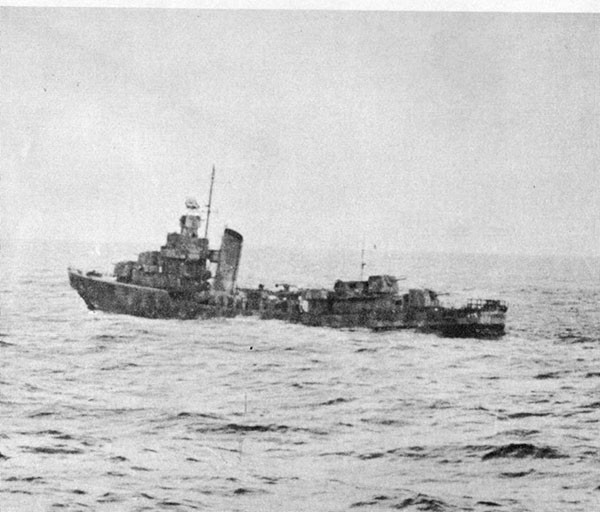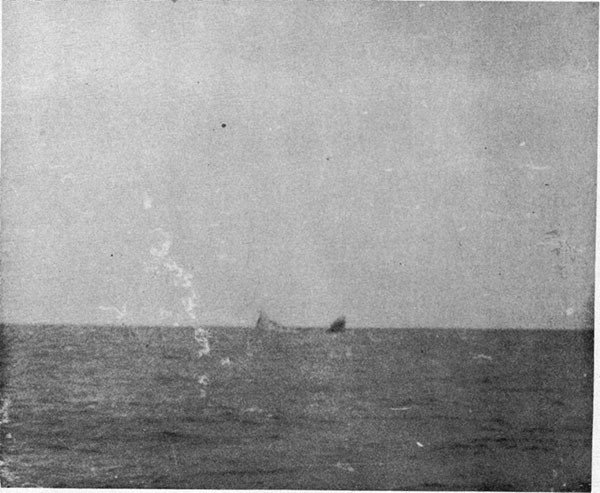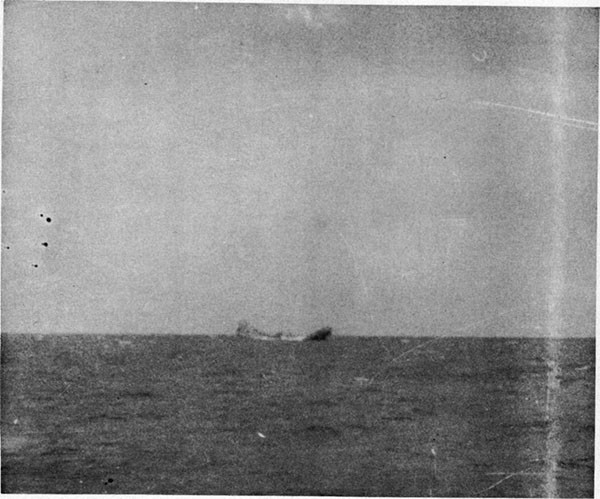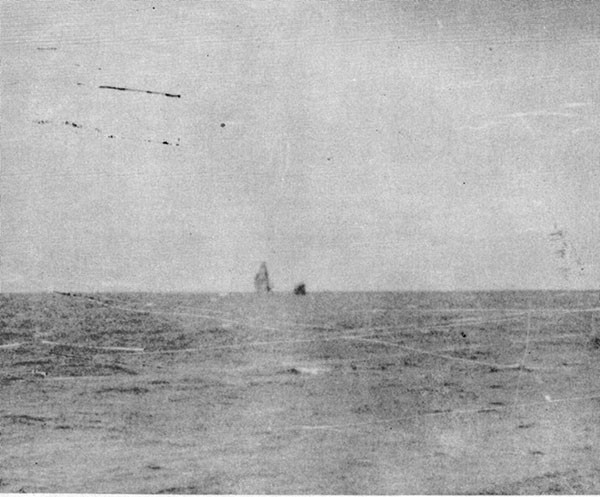Status - John Skinner - USS O'Brien:
On the 18th, problems worsened all day, and by the afternoon, the crew was informed of the possible need to abandon ship and that preparations had been made. Course was set for Pago Pago, the nearest port, with the emergency destination of the island of Upolu, Western Samoa.
Overnight the flooding became worse, and by morning, the ship had more severe damage, as cracks had formed in several areas. The bottom opened up at 6:00 AM, and the deck began to rupture about a half hour later, at which point the order to abandon ship was given. The crew spent several hours in lifeboats and in the water. Many had to swim to the accompanying vessels. The sharks having business elsewhere that day, all hands were rescued.
Around 8:00 AM, the end came for O'Brien. Below are pictures of the sinking, as the bow and stern folded upwards but did not separate, and the ship sank slowly as one unit, still held together by the main deck.




Click Read More to see the full narration of the last day from Damage Report #28, pp. 6-8:
By early morning of the 18th the rate of leakage had again increased to the extent that one fire and bilge pump had to be operated at high speed to hold the water level constant. At 0500 two pumps were put on in order that each might run slowly. At 0500 inspection revealed that the reinforcement of No. 6 port longitudinal had again cracked and the hull plating just outboard of this longitudinal had a three-inch crack along a wrinkle. These occurrences did not appear alarming but the Task Group Commander was notified. Rate of leakage continued to increase and by 0900 the main circulator was again put on bilge suction and the two fire and bilge pumps secured. About 1000, No. 6 port longitudinal and the damaged vertical keel were found cracked wide open. Cracks were developing in the shell under the main condenser and in the other damaged deep longitudinals and their reinforcing plates. Thus, the situation was progressively becoming more serious.
It was recommended to the Task Group Commander that O'BRIEN proceed to the nearest anchorage. At 1018 course was changed towards Pago Pago and to pass Upolu close aboard. All depth charges were disarmed by removal of pistols. Material Condition Affirm was set. About 1130 heavy topside weights were ordered jettisoned. These consisted mainly of the 5" loading machine, two anchors, deck winch, deck lubricating oil tank and torpedo after bodies and air flasks.
Rate of leakage continued to increase slowly. In the afternoon, although other conditions seemed unchanged, preparations were made for abandoning the forward engine room. As both main generators and the main switchboard were in the forward engine room, temporary leads were run to insure that the emergency diesel generator would keep the after engine room blowers and the electric auxiliaries of the condensing plant in operation. Main, auxiliary and bulkhead steam stops were closed about two-thirds. Emergency signals were arranged between firerooms and engine rooms and operating personnel were advised of the emergency procedure to be used.
Later in the afternoon the crew was assembled at quarters, advised of the seriousness of the situation and informed that LANG and CIMARRON had made adequate preparations for rescue. The Commanding Officer also informed the crew that he still expected O'BRIEN to reach port intact.
During the night hourly inspections were made. At 2300 the main circulator was running at half-speed. Two fire and bilge pumps were put on bilge suction and the main circulator was slowed to one-third. At 0100 on the 19th, conditions seemed unchanged. By 0200 rate of leakage had increased slightly. By 0300 there was still more leakage.
At about 0337 a shell plate on the port side behind the dynamo condenser cracked open with the noise of a pistol shot. Rate of leakage immediately increased and main circulator speed was increased to full. Water level still continued to rise slowly. Speed was reduced to nine knots. At 0339 speed was reduced to five knots and course was changed to lessen the working of the ship. At this time the sea was still moderate and force of the wind somewhat less than force four. The Task Group Commander directed O'BRIEN to further lighten ship and a large quantity of 5" projectiles, depth charges and additional torpedo after bodies and air flasks were jettisoned.
During the night the Task Group Commander debated the advisability of either CIMARRON or LANG taking O'BRIEN in tow as all vessels were prepared for this action. Decision not to take O'BRIEN in tow was based on the consideration that propeller thrust was desirable by virtue of tending to close the break, whereas towing would tend to open it. This opinion was shared by the Commanding Officer of O'BRIEN.
About 0402 course was again changed to close the nearest land. At 0410 water reached the auxiliary panel and main circuit breakers tripped out. Main generators were secured and the emergency diesel generator cut in. Water was five feet deep and rising. By 0430 heat made the forward engine room untenable and the starboard engine was secured and the engine room abandoned. At this time Upolu was only 40 miles to the southeast. Instructions were given to keep the port engine operating at all costs in an effort to reach Upolu and, at the same time, to maintain propeller thrust to reduce the tendency of the vessel to break in two.
The forward engine room flooded to the waterline. As this occurred, the after bulkhead of the after fireroom deflected forward. The after fireroom was then abandoned to prevent possible injury to personnel if the bulkhead collapsed. The forward fire-room supplied sufficient steam to the port engine to maintain the speed of five knots.
At 0600 the bottom suddenly opened considerably and the forward and after portions of the hull began to work independently. At 0605 the starboard side cracked open up to the main deck at frame 105. The two ends of the vessel were working severely. The main deck was still intact and pipe lines joining the two portions assisted in preventing complete rupture at this time. However, piping was working through the after bulkhead of the after fireroom which was flooding. At 0610 it was apparent that the situation was critical. All of the machinery plant was secured and abandoned. Hogging and sagging were violent and the two lower halves of the hull were alternately butting and parting.
At 0625 the main deck started to rupture on the starboard side at frame 105. O'BRIEN, with the approval of the Task Force Commander, was ordered abandoned. About 0630 all hands, except the nucleus crew, went over the side. As conditions grew progressively worse decision was made by the Commanding Officer, and approved by Commander Task Group 66.3, to abandon O'BRIEN completely. This was completed by 0701. O'BRIEN was left equipped for towing.
It was hoped that one or both sections of the vessel would float and permit salvage. This was not the case. Photos 6 to 9 inclusive show the death throes of O'BRIEN. At 0746 both bow and stern took a sharp permanent upward set with the keel visible under gun No. 1 and the propellers clear of the water. At 0753 the vessel rolled slowly and deeply to starboard. It has slowly righted itself and, when upright, the main deck was awash amidships. The ends slowly folded together with bow and stern rising in the air and the hull as a unit slowly settling. At 0757 the stern went under, followed a little later by the bow. There were no explosions. O'BRIEN had steamed 1027 miles from Suva to the location where sinking occurred. Altogether a total distance of about 2800 miles had been steamed from the time of torpedoing.
U. S. Navy Task Forces:
- Task Force 16 (Enterprise) sailed from Pearl Harbor on October 16th for the South Pacific, crossing the equator on the 19th.
- Saratoga remained at Pearl Harbor for repairs (sailed November 10th).
- Combined
Task Force 61 remained on patrol in the Coral Sea near Guadalcanal.
- Task Force 17 (Hornet) -> TF 61
More Information:
- Official Navy Chronology, pp. 264-266.
- The First Team and the Guadalcanal Campaign, John B. Lundstrom, pp 321-334.
- The Struggle for Guadalcanal, Samuel Eliot Morison, pp. 181-190.
- Neptune's Inferno, The U.S. Navy at Guadalcanal, James D. Hornfischer, pp. 200-213.
- U.S.S. O'Brien (DD415) Torpedo Damage and Loss South Pacific 15 Sept. - 19 Oct. 1942, War Damage Report #28, pp. 1-15.
NEXT POST: OCTOBER 24TH
No comments:
Post a Comment